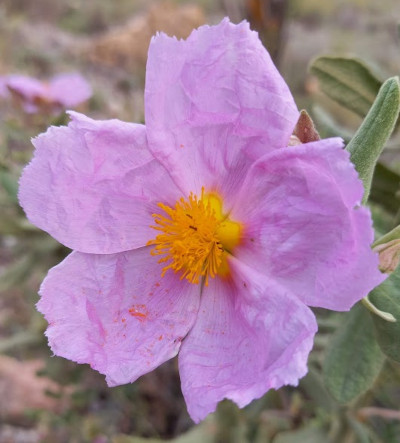
La Jara Blanca (Cistus albidus)

 La Jara Blanca (Cistus albidus): Spain’s Sun-Loving Wildflower
La Jara Blanca (Cistus albidus): Spain’s Sun-Loving Wildflower
The English name for this flower is Grey-leaved Rockrose or Spanish Pink Rockrose.
For people who like walking in the hills in Spain (senderistas) the Pink Rockrose is a common sight and maybe you have wondered exactly what it is. I have tried to grow Cistus albidus from a seed a couple of times but it never germinates. This is true of many wild flowers which manage to survive in very difficult environments. If you try and spoil them with fancy shop bought seed compost they are not interested and refuse to germinate. So until I crack their complicated germination requirements I will have to just enjoy them in their natural habitat. The rest of this article was written with the help of AI.

Among the sun-drenched hillsides and rocky slopes of the Spanish countryside, you’ll often spot a low, bushy plant covered in wrinkled lavender-pink flowers and silvery leaves. This is La Jara Blanca (Cistus albidus), a Mediterranean wildflower that plays an important role in local ecosystems — and in the hearts of nature lovers.
 Botanical Profile
Botanical Profile
- Scientific name: Cistus albidus
- Common Spanish name: Jara blanca
- Family: Cistaceae (rockrose family)
- Height: 30–100 cm
- Flowering period: March to June
- Native range: Mediterranean Basin, especially widespread in Spain, Portugal, southern France, and parts of North Africa
 How to Recognize It
How to Recognize It
La jara blanca is easily recognized by its distinctive pale green to whitish foliage, which is covered in fine hairs, giving it a silvery or “whitewashed” look — hence the name albidus (“whitish” in Latin).
Its flowers are crinkled and papery, usually pink to purple with a bright yellow center. Each flower lasts only one day, but the shrub produces blooms in abundance during spring.
 Where It Grows
Where It Grows
This wildflower thrives in dry, rocky soils, particularly in:
- Scrubland (matorral)
- Open pine or holm oak forests
- Sunny mountain slopes and limestone-rich hillsides
- Areas affected by fire — it’s one of the first plants to reappear
It is incredibly drought-tolerant and well-adapted to the Mediterranean climate, requiring little water and poor soil to thrive.
 Ecological Role
Ecological Role
La jara blanca is more than just a pretty face — it plays a vital ecological role:
- Pollinator magnet: Bees, butterflies, and beetles are drawn to its nectar-rich flowers.
- Soil stabilizer: Its root system helps prevent erosion on dry hillsides.
- Fire resilience: Though easily burned, it regenerates quickly after wildfires, helping to restore degraded habitats.
- Medicinal use: In traditional herbal remedies, some species of Cistus have been used for their anti-inflammatory and antimicrobial properties (though Cistus albidus is less commonly used this way than its cousin Cistus ladanifer).
 Fun Facts
Fun Facts
- The leaves contain aromatic resins, which release a pleasant, herby scent when warmed by the sun.
- The plant’s beauty and resilience make it a popular choice for wildflower gardens and xeriscaping (low-water landscaping).
- It's part of the Mediterranean maquis — a type of plant community that includes aromatic shrubs, herbs, and evergreens.
 In Spanish Culture
In Spanish Culture
While Cistus ladanifer (jara pringosa) is more famous for its sticky resin (labdanum), jara blanca is often appreciated in southern Spain for its delicate blooms and silvery appearance, evoking peace and purity in local folklore.
1,116 views of this article.
Last Modified on April 19th, 2025
Created on April 19th, 2025
2,561,751 Total Views
This article is part of the following category. Click on the link to see a list of similar articles:
Go to homepage
Below is a list of the most highly rated places to visit in Spain
Click on the links to see the most popular activities that you can do in these places:
Note that the booking system uses a Spanish system and there is no involvement of any American company and no US tariffs.
